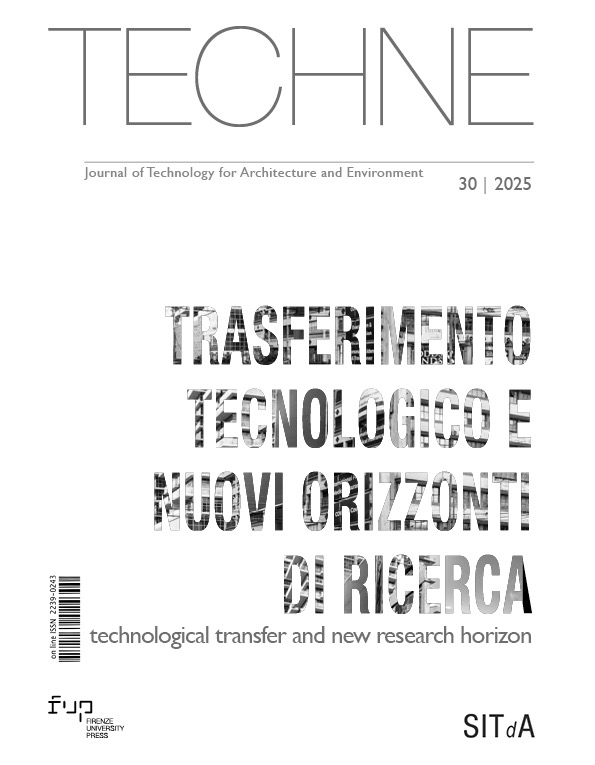Published 2025-11-07
Keywords
- Technological and environmental design,
- Third Stream; R&D; SMEs; technology transfer; innovative activities.,
- Implementation design,
- Design for assembly and manufacturing,
- Advanced building systems
How to Cite
Copyright (c) 2025 MASSIMILIANO NASTRI

This work is licensed under a Creative Commons Attribution 4.0 International License.
Abstract
The study examines the theoretical-methodological approaches (undertaken by the Technology Research & Development Office, in the Third Mission exercise) directed towards the practices of “technological substitution” and “typological re-configuration” of building systems. The methodological process involves incremental transformation techniques aimed at controlling and reducing complexity, supporting both Architectural Engineering Services and Systems Manufacturing Stakeholders. The thesis aims to provide an evaluation method to determine the technical, economic and time effectiveness of systemic evolution procedures, as well as potential transfer developments calibrated by the practices of Topology Optimisation and Advanced Manufacturing.
Downloads
References
- Arashpour, M., et al. (2017), “Optimizing decisions in advanced manufacturing of prefabricated products: Theorizing supply chain configurations in off-site construction”, Automation in Construction, Vol. 84, pp. 146-153. Available at: https://doi.org/10.1016/j.autcon.2017.08.032. DOI: https://doi.org/10.1016/j.autcon.2017.08.032
- Benneworth, P., de Boer, H. and Jongbloed, B. (2015), “Between good intentions and urgent stakeholder pressures”, European Journal of Higher Education, Vol. 5, n. 3, pp. 280-296. Available at: https://doi.org/10.1080/21568235.2015.1044549. DOI: https://doi.org/10.1080/21568235.2015.1044549
- Conti, G. and Grimaldi, R. (2024), Knowledge Share: the (R)evolution of Technology Transfer, Springer, Cham. Available at: https://doi.org/10.1007/978-3-031-51384-8. DOI: https://doi.org/10.1007/978-3-031-51384-8
- Cool, V., Aage, N. and Sigmund, O. (2025), “A practical review on promoting connectivity in topology optimization”, Structural and Multidisciplinary Optimization, Springer, Vol. 68, n. 73. Available at: https://doi.org/10.1007/s00158-025-04004-z. DOI: https://doi.org/10.1007/s00158-025-04004-z
- Dewagoda, K. G., et al. (2024), “Design for Circular Manufacturing and Assembly (DfCMA): Synergising Circularity and Modularity in the Building Construction Industry”, Sustainability, Vol. 16, pp. 27. Available at: https://doi.org/10.3390/su16219192. DOI: https://doi.org/10.3390/su16219192
- Donofrio, M. (2016), “Topology Optimization and Advanced Manufacturing as a Means for the Design of Sustainable Building Components”, Procedia Engineering, Vol. 145, pp. 638-645. Available at: https://doi.org/10.1016/j.proeng.2016.04.054. DOI: https://doi.org/10.1016/j.proeng.2016.04.054
- Hu, X., et al. (2019), “Understanding Stakeholders in Off-Site Manufacturing”, Journal of Construction Engineering and Management, Vol. 145, n. 8, pp. 40. Available at: https://doi.org/10.1061/(ASCE)CO.1943-7862.000167. DOI: https://doi.org/10.1061/(ASCE)CO.1943-7862.0001674
- Hyun, H., Kim H.-G., Kim, J.-S. (2022), “Integrated Off-Site Construction Design Process including DfMA Considerations”, Sustainability, Vol. 14, n. 7. Available at: https://doi.org/10.3390/su14074084. DOI: https://doi.org/10.3390/su14074084
- Kwok, T. C., et al. (2023), “Facilitating innovation and knowledge transfer between homogeneous and heterogeneous datasets”, Journal of Innovation & Knowledge, Vol. 8, n. 2. Available at: https://doi.org/10.1016/j.jik.2023.100313. DOI: https://doi.org/10.1016/j.jik.2023.100313
- Landsec (2024), Uk’s-first net-zero-carbon-commercial. Available at: https://landsec.com/insights/future-trends/development/another-milestone-uks-first-net-zero-carbon-commercial.
- Laovisutthichai, V. and Lu, W. (2021), “Architectural design for manufacturing and assembly for sustainability”, in Lau, S. S. Y., et. al. (Eds.), Design and Technological Applications in Sustainable Architecture, Springer, Cham, pp. 219-233. Available at: https://doi.org/10.1007/978-3-030-80034-5_15. DOI: https://doi.org/10.1007/978-3-030-80034-5_15
- Mesa, J. A., Esparragoza, I. and Maury, H. (2020), “Modular architecture principles. MAPs: A key factor in the development of sustainable open architecture products”, International Journal of Sustainable Engineering, Vol. 13, n. 2, pp. 108-122. Available at: http://doi.org/10.1080/19397038.2019.1634157. DOI: https://doi.org/10.1080/19397038.2019.1634157
- Montali, J. et al. (2017), “Knowledge-based engineering in the design for manufacture of prefabricated façades”, Architectural Engineering and Design Management, Vol. 14, pp. 1-17. Available at: https://doi:10.1080/17452007.2017.1364216. DOI: https://doi.org/10.1080/17452007.2017.1364216
- Najid, N.-M., Castagna, P. and Kouiss, K. (2020), “System Engineering-Based Methodology to Design Reconfigurable Manufacturing Systems”, in Benyoucef, L. (Ed.), Reconfigurable Manufacturing Systems: From Design to Implementation, Springer, Cham, pp. 29-55. Available at: https://doi.org/10.1007/978-3-030-28782-5_3. DOI: https://doi.org/10.1007/978-3-030-28782-5_3
- Pontis, S. (2021), “Understanding the impact of supporting conceptual information design”, Information Design Journal, Vol. 26, n. 1, pp. 33-52. Available at: https://doi.org/10.1075/idj.20015.fon. DOI: https://doi.org/10.1075/idj.20015.fon
- Prokhorova, V., et al. (2024), “Building a model for evaluating the efficiency of circular transformations in the context of technology transfer”, Eastern-European Journal of Enterprise Technologies, Vol. 129, n. 13, pp. 100-112. Available at: https://doi.org/10.15587/1729-4061.2024.303992. DOI: https://doi.org/10.15587/1729-4061.2024.303992
- Ragulina, Y.V. (2019), “Priorities of development of industry 4.0 in modern economic systems with different progress in formation of knowledge economy”, in Popkova, E., et al. (Eds.), Industry 4.0: Industrial Revolution of the 21st Century, Vol. 169, Springer, Cham, pp. 167-174. Available at: https://doi.org/10.1007/978-3-319-94310-716. DOI: https://doi.org/10.1007/978-3-319-94310-7_16
- Roxas, C.L.C. et al. (2023), “Design for manufacturing and assembly (DfMA) and design for deconstruction (DfD) in the construction industry”, Buildings, Vol. 13. Available at: https://doi.org/10.3390/buildings13051164. DOI: https://doi.org/10.3390/buildings13051164
- Swilling, M. (2020), The age of sustainability, Routledge, London. Available at: https://doi.org/10.4324/9780429057823. DOI: https://doi.org/10.4324/9780429057823
- Tan, T., et al. (2020), “Construction-Oriented Design for Manufacture and Assembly (DfMA) Guidelines”, Journal of Construction Engineering and Management, Vol. 146, n. 8, pp. 20. Available at: https://doi.org/10.1061/(ASCE)CO.1943-7862.0001877. DOI: https://doi.org/10.1061/(ASCE)CO.1943-7862.0001877
- Wasim, M., et al. (2020), “An approach for sustainable, cost-effective and optimized material design for the prefabricated non-structural components”, Journal of Building Engineering, Vol. 32, n. 2. Available at: https://doi:10.1016/j.jobe.2020.101474. DOI: https://doi.org/10.1016/j.jobe.2020.101474
- Wise, A. F. and Vytasek, J. (2017), “Learning Analytics Implementation Design”, in Lang, C., et al., Handbook of Learning Analytics, Society for Learning Analytics Research, Beaumont, pp. 151-160. Available at: https://doi.org/10.18608/hla17.013. DOI: https://doi.org/10.18608/hla17.013






